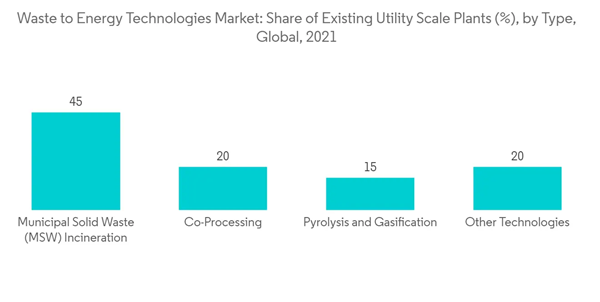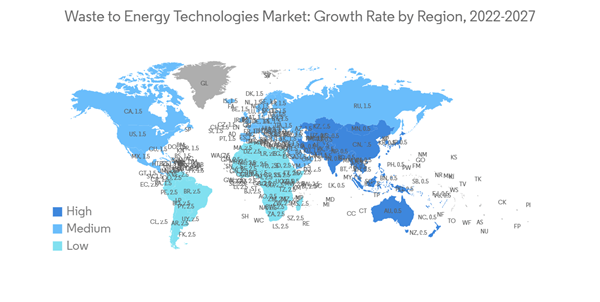The waste-to-energy technologies market is expected to record a CAGR of more than 3% during the forecast period.
The market was negatively impacted by COVID-19. Presently, the market has reached pre-pandemic levels.
This product will be delivered within 2 business days.
The market was negatively impacted by COVID-19. Presently, the market has reached pre-pandemic levels.
Key Highlights
- The factors driving the market include supportive government initiatives and efforts to reduce dumps and open burning of waste in both developed and emerging economies across the world.
- However, the high capital and operation cost of waste-to-energy plants and the requirement of skilled staff to operate and maintain the sophisticated technologies may act as a restraint to the market's growth in the future.
- Waste generation is overgrowing with the increasing population. The global waste is expected to reach around 3.4 billion tons by 2050. The direct relation between population and income level is expected to increase the waste volume. Daily per capita waste generation in developed and emerging economies is also expected to increase by 40%. The need to stabilize future waste may increase the adoption of waste-to-energy technology in the future.
- Europe is one of the prominent regions to have waste-to-energy technology as it has a significant potential to reduce the region's dependency on gas imports while helping it participate in the efforts toward a carbon-neutral Europe.
Waste-to-Energy Technologies Market Trends
Municipal Solid Waste Incineration (MSWI) as a Prominent Technology
- During the MSWI process, waste materials are burned inside a specific chamber by raising the temperature to around 850-1450 degrees Celsius, and oxygen is added to have a combustion reaction. A minimum calorific value of the waste is required for the self-combustion of the trash.
- During the process, exhaust gases called flue gases are created, which are cleaned up before exiting the facility. This flue gas contains the heat energy that is utilized to generate electricity or for heating purposes.
- The operation of MSWI is more complex than the operation of a sanitary landfill. It requires well-developed technical and management skills to set and adjust the parameter for the effective operation of the plant.
- With the several advantages of MSWI, the segment is expected to be the prominent technology as compared to other segments. The normal range of net electrical energy that can be produced per ton of waste burnt is 500-600 kWh. Thus, the incineration of around 2,200 ton of waste each day will generate approximately 50 MW of electrical power.
- Therefore, due to such advantages and benefits, municipal solid waste incineration (MSWI) is expected to grow during the forecast period, further driving the waste-to-energy technologies market.
Europe as a Significant Market
- Europe is one of the prominent regions to have developed its waste-to-energy technology. According to the Confederation of European Waste-to-Energy Plants (CEWEP), waste-to-energy plants could produce 189 TWh of useful energy per year by 2035, which would be equivalent to 19.4 billion m³ of natural gas in terms of primary energy.
- Due to cold weather, Sweden and Denmark have several combined heat and power (CHP) waste-to-energy plants, like Aros, Vartan, Herning, etc., which generate more than 100 kilowatt (kW) electricity of energy.
- Europe is estimated to have nearly 330 waste-to-energy plants in the future, with a capacity of around 50 million metric tons annually. The addition of plants is expected to control the rising volume of waste in the region.
- Germany had the most municipal waste energy plants installed capacity in Europe in 2021. In the same year, roughly 1,010 megawatts were deployed around the country. In total, Europe's waste-to-energy capacity was 5.1 gigatons.
- In April 2022, a joint venture initiative with the Aarau-Lenzburg Regional Waste Disposal Association (GEKAL) was established with HZI, the Swiss-Japanese cleantech enterprise. HZI plans to use power from the Buchs Energy from the waste plant to electrolyze hydrogen and oxygen. An alkaline electrolysis method capable of producing 550 Nm3/h of green hydrogen at 350 bar will be employed, meeting both the SAE 2719 and ISO 14687 quality standards for hydrogen fuel.
- Thus, with the increasing installed capacity and development of initiatives in waste-to-energy technologies, Europe is expected to record a high CAGR during the forecast period.
Waste-to-Energy Technologies Market Competitor Analysis
The waste-to-energy technologies market is moderately fragmented. The key owners/operators in the market (not in a particular order) include Babcock & Wilcox Enterprises Inc., Ramboll Group AS, Veolia, Babcock & Wilcox Volund AS, Hitachi Zosen Inova AG, and Suez Environnement.Additional benefits of purchasing the report:
- The market estimate (ME) sheet in Excel format
- 3 months of analyst support
This product will be delivered within 2 business days.
Table of Contents
1 INTRODUCTION
4 MARKET OVERVIEW
5 MARKET SEGMENTATION
6 COMPETITIVE LANDSCAPE
Companies Mentioned (Partial List)
A selection of companies mentioned in this report includes, but is not limited to:
- Babcock & Wilcox Enterprises Inc.
- Ramboll Group AS
- Veolia Group
- Babcock & Wilcox Volund AS
- Hitachi Zosen Inova AG
- Suez Environnement
- China Everbright International Limited
- Covanta Holding Corporation
- Amec Foster Wheeler PLC
- Abu Dhabi National Energy Company PJSC (Taqa)
Methodology

LOADING...










